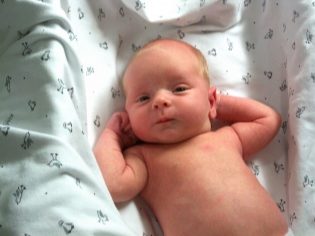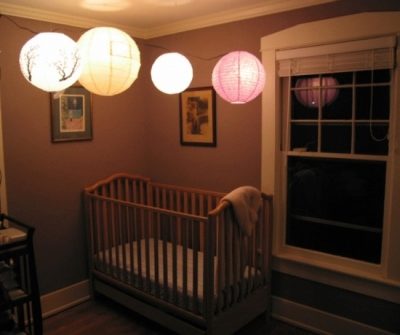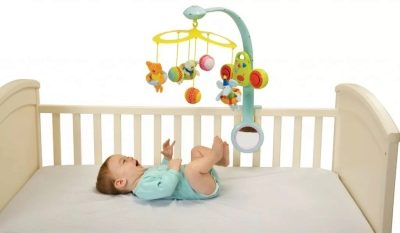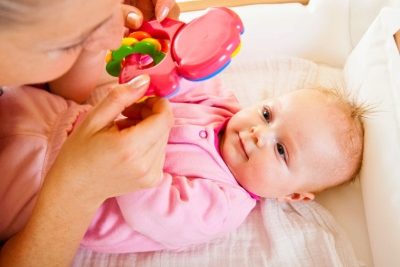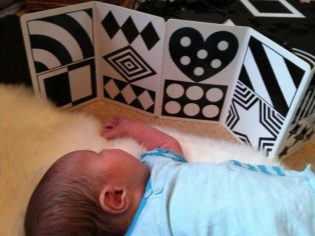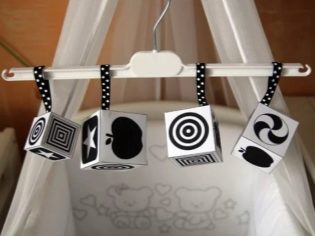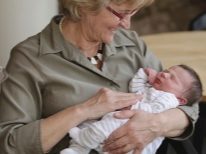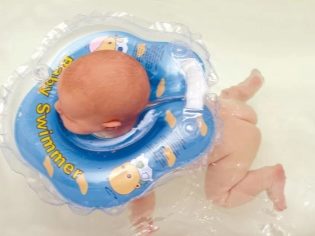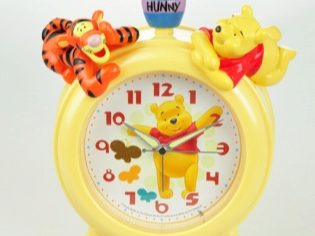How to develop a child in 1 month?
In vain most adults think that a month-old baby needs only nutrition, as well as sleep. The needs of the crumbs are growing every day. He already knows a lot and is capable of much, and therefore developing classes with a peanut who is already 1 month old is not only an unconditional benefit for his development, but also a great pleasure for all participants of this process without exception. Let's take a closer look at how and what you can do with the baby of this age group.
Benefit
For the first month of their independent life, the crumb has almost completely adapted to the world around it. It is the most opportune time to introduce the toddler with this world in more detail. Of course, the baby still spends most of the time in a dream. However, the periods of wakefulness have already become a little longer, and this should definitely be used.
Do not think that classes with a child who is only 1 month old will make a real child prodigy out of a baby. They have another goal - to establish close and pleasant communication, which absolutely all people need, be it a month old or five decades old. Contact with mom, dad, brothers and sisters, if any, is important for infants. On this and need to be based, planning the first in the life of the little developmental activities.
Principles of Occupation
It is important to remember that a child at this age is not able to concentrate his gaze on one point for a long time, he does not hold the head himself and gets tired very quickly. In short periods of wakefulness, it is not worth overloading the child with exercises that are accompanied by loud sounds, too bright light. Try to prevent your child from being surrounded by too many people; his mother and father are enough for him. However, gathering around the toddler all the big family is by no means worth it.
In all exercises and games, try to provide tactile contact, it is very important for the crumbs. Turn on soft music, better classical, make sure the light is muffled. All classes spend in the daytime. In the evening, before going to sleep at night, it is better not to disturb the baby.
The main principle of the study is the development of the senses. Vision, hearing, smell and touch will help him more effectively to learn all the possibilities of the surrounding world, which so far seems to the new person to be such a stranger. At the age of 1 month, it is possible and necessary to develop the physical data of the child - the musculature, the nervous system.
Suitable games for development
Big teddy bears and colorful cars that you have undoubtedly already given as a gift are completely useless for a month-old baby. A bright and contrasting mobile is more suitable for him at this age - a carousel for the bed, large rattles (mostly yellow, green, blue, red and white). You can print black-and-white drawings on the printer, which show a chessboard or a contrasting spiral.
To develop each of the senses is necessary with the help of special exercises. There are a lot of them, but let's dwell on those that are time tested.
Vision
If the newborn sees a cluster of blurred and devoid of spots, then the baby, who is already 1 month old, is quite able to focus on a certain bright color object for a short time. The baby can look at the big rattle with interest.It is still difficult, but he may already start trying to follow her with his gaze. All exercises for the development of visual function are based on this.
At first it is enough if the mother demonstrates the toy to the baby static. In this case, the distance between the face of the crumbs and the subject should not be less than 35-40 centimeters. The same rule applies to tying toys to the crib. You will notice that the kid will quickly learn to look at the items on display.
After that, you can move on to more complex exercises: moving the rattle horizontally left and right, then up and down vertically. When the peanut will surely follow the movement with his eyes, you can practice cross-movement - vertically, in a circle.
The movements of the hands of adults should not be too harsh, frightening, and the sounds that most children's toys make should not be loud and shrill.
Black and white images that are based on simple geometric shapes and color contrasts of black and white are perfect. Leaves with such patterns can be fixed on the bed - first to the right of the crumbs, then to the left. He will look at them with interest.
Hearing
The voice of his mother the newborn knows very well and will always distinguish him from the voices of other people. Classes for the development of hearing should be based on voice communication. Intonation should prevail in it. Loud rattles, rubber toys-tweeters leave until better times, replace them with emotional communication, which should accompany any activities, procedures, feeding. Lullabies, rhymes, tender words - the baby will accept all this with gratitude.
In addition, it is important to teach the baby to distinguish which side a particular sound is coming from. Rattles with a gentle and quiet sound, bells that can be sewn onto a fabric base will help. The exercises are based on moving the sounding object: first to the left of the baby, then from the side of the right ear.
Quiet calm music has a beneficial effect on the baby. Watch your child, his reaction to music will be instant. You will see that his eyes are more focused, he smiles and is completely calm.
Touch
As already mentioned, tactile sensations are very important and informative for the infant. At the age of one month, the baby cannot take different toys according to its texture, but the mother can put small pieces of different fabrics (velveteen, silk, chintz, lace) on the child's delicate skin. You can use fabric mittens for baby bathing and turn the usual hygienic ritual into a developmental activity that perfectly stimulates the sense of touch.
Emotions
The strongest emotional factor for a small child is mother. He not only unmistakably guesses her mood and state, but he himself reacts to it. That is why it is better to cast away all experiences, starting to practice with the baby.
Communication should be joyful and positive, then the child will be more calm and responsive to the emotions of adults.
All crumbs, without exception, love it when mom “talks” with their tummies. To do this, touch your lips to the belly of the baby and tell him something - it does not matter what it is, because he will first of all react to pleasant vibrations. Smile often, turning to the baby.
Musical development
Music for the child is also useful, but it should not be loud and long. It is enough to turn it on for 10-15 minutes - two or three times a day. It is better if these are melodies and compositions that mother most often listened to during pregnancy, because the child already “knows” them. Classical music has an excellent developmental and even health-improving effect, especially the works of composers such as Mozart and Vivaldi. Sing to the child more often, say "singsong", all this forms in the crumbs a positive perception of sounds.
For physical development
At the age of one month, it is useful to spread the child on the tummy: this not only has a positive effect on the intestinal work and reduces the appearance of intestinal infantile colic, but also trains the muscles of the abdomen and back. The child begins to try to hold the head, and this stimulates the muscles of the neck and shoulder girdle.
Gymnastics and exercises
Gymnastics for a monthly baby should be a daily ritual, because morning exercises are useful to everyone without exception, regardless of age. It should not be too intense, the movement of the arms and legs should be done carefully. Recommended exercises are bending and unbending arms and legs, carefully spreading the legs in the hips, lifting the handles up and down.
Massage
Strokes and pats should not be too strong. It is best to do a massage before evening bathing. Separately, stroke hands, legs, tummy (clockwise), and then, turning the child on the tummy, gently stroke the back. All movements are done in order to remove the muscle tone that every newborn has. If he is very strong, the neurologist will most likely recommend a special massage from specialists.
Massage and gymnastics help your baby grow healthy and grow faster. What are the most common mistakes parents make during a massage? A professional children's masseuse gives detailed instructions.
Swimming
It is no secret that all children from birth can swim. However, only a few among the parents are ready to immediately throw the monthly child into the pool and send him to float freely. Groups for infants come to the rescue, which now exist in almost every pool or palace of water sports. Mom and baby can enjoy water treatments under the supervision of an experienced trainer with a medical education.
For home swimming procedures, you can use a special circle. Baby swimmerwhich is on sale in network children's shops, orthopedic salons. He securely holds the baby’s cervical spine, his head is always above the water. The baby will be able to swim in the circle both on the back and on the tummy, and it will begin to roll over in the water almost from the first lessons.
Tips for parents
Do not overload the child with new information. Enter any new types of activities gradually, starting from 1 minute for the period of wakefulness and bringing the time to 4-5 minutes, and by the end of the month - up to 10 minutes.
If you are going to start doing exercises for physical development, gymnastics, massage, be sure to consult with the pediatrician. There are diseases and congenital defects in which massage should be therapeutic in nature. In such cases, do it yourself is not recommended.



